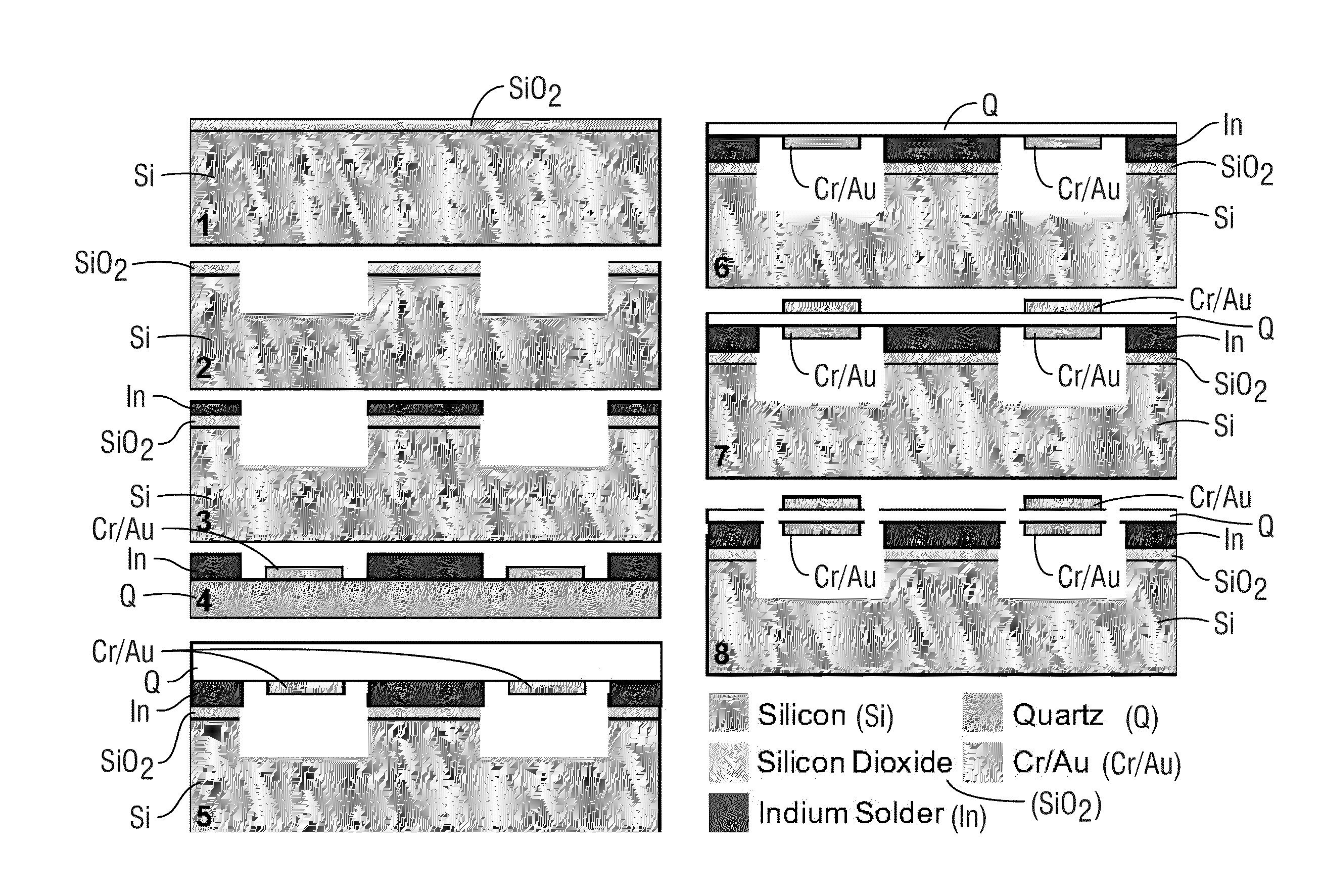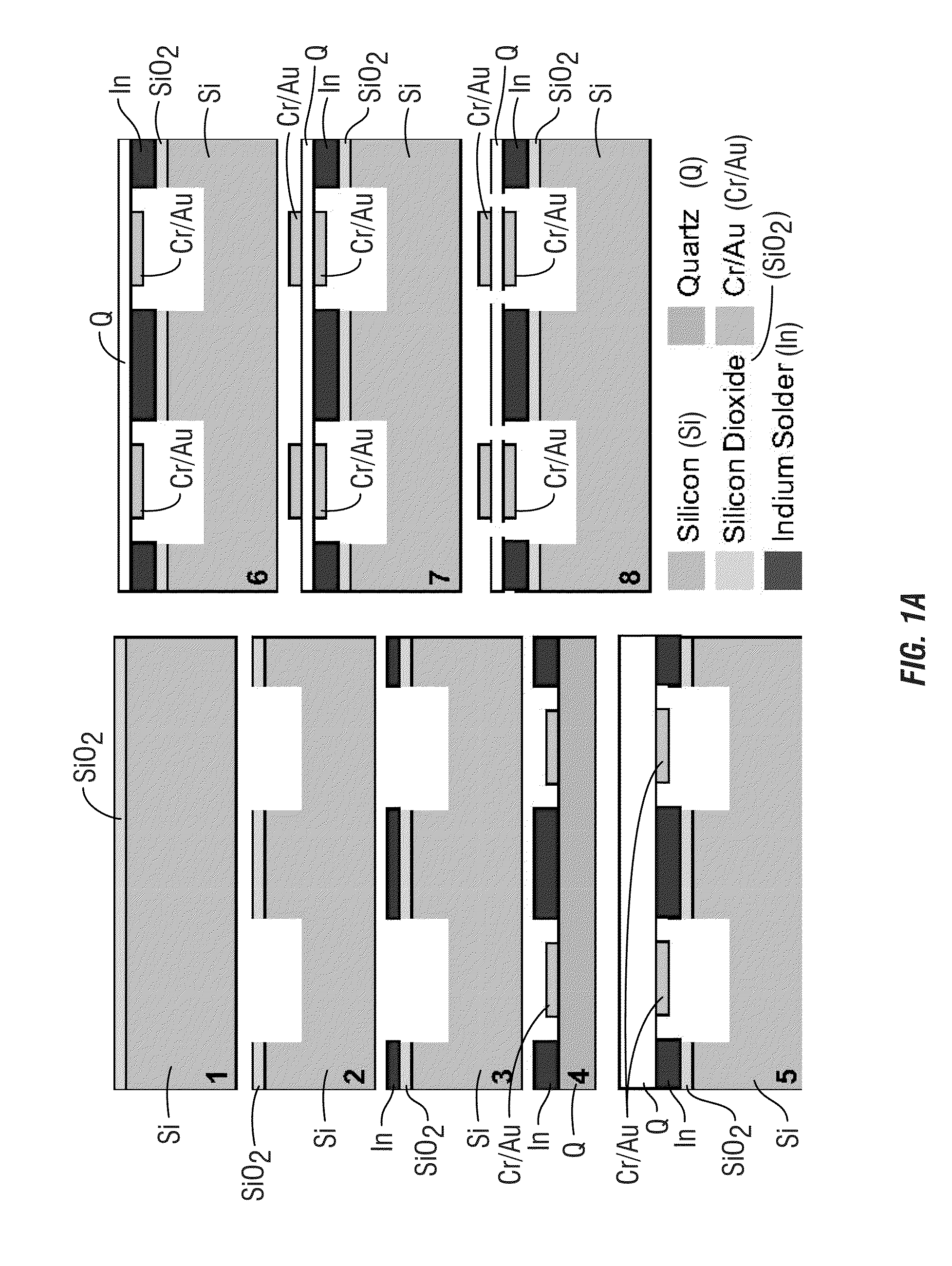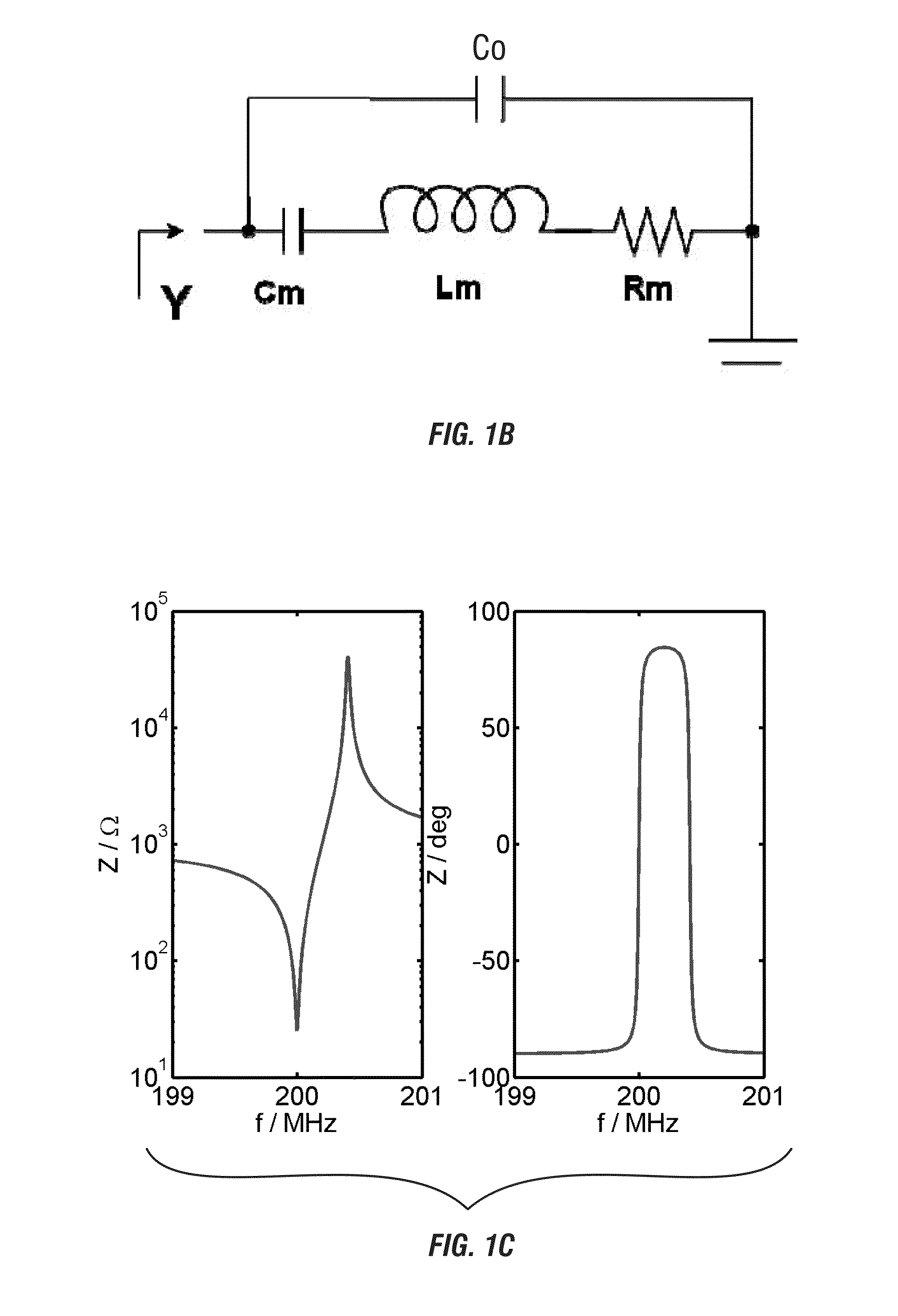Methods and apparatus for ultra-sensitive temperature detection using resonant devices
- Summary
- Abstract
- Description
- Claims
- Application Information
AI Technical Summary
Benefits of technology
Problems solved by technology
Method used
Image
Examples
exemplary embodiment 1
A. Exemplary Embodiment 1
General Method, Apparatus and System
[0097]Two prominent aspects are as follows.
[0098]1. Fabrication Method
[0099]Fabrication of extremely small thermal mass quartz resonance-based calorimetric sensors allows the sensors to be placed in close proximity to the event to be measured. Similarly, fabrication of extremely small vessels or reaction chambers, and the ability to position the sensors near the event but neither touching the reaction chamber nor requiring placement of the analyte on the sensor, improve sensitivity of the measurements.
[0100]In the examples of Exemplary Embodiments 1-3, Y-cut quartz monolithic crystals are utilized. Micromachining techniques are well-known in the art (see, e.g., Marc J. Madou, “Fundamentals of MicroFabrication, CRC Press, Boca Raton, Fla., USA, 2002, (2nd Edition)).
[0101]Typical conventional quartz elements used in resonant sensors are on the order of 80 to 600 μm thick with resonant frequencies in the range of 3 to 20 MHz ...
exemplary embodiment 2
References for Exemplary Embodiment 2
[0203]1. Karube, K. Sode, and E. Tamiya, Journal of Biotechnology 15, 267-281 (1990).[0204]2. H. C. Cantor, V. Padmanabhan, P. Favreau, and A. Midgley Jr, Endocrinology 137, 2782-2790 (1996).[0205]3. M. Shichiri, M. Sakakida, K. Nishida, and S. Shimoda, Artificial Organs 22, 32-42 (1998).[0206]4. K. Ramanathan, M. Khayyami, and B. Danielsson, in Affinity Biosensors: Techniques and Protocols; Vol. 7, edited by K. R. Rogers and A. Mulchandani (Humana Press, 1998), p. 19-29.[0207]5. Y. Guan, P. M. Evans, and R. B. Kemp, Biotechnology and Bioengineering 58, 464-477 (2000).[0208]6. B. Danielsson, J. Biotechnology 15, 187-200 (1990).[0209]7. B. Eggins, Biosensors: An Introduction (Wiley Teubner, Chichester, 1996).[0210]8. J. T. Edsall, Biothermodynamics: The study of Biochemical Processes at Equilibrum (John Wiley, Chichester, 1983).[0211]9. I. Jelesarov, L. Leder, and H. R. Bosshard, Methods 9, 533-541 (1996).[0212]10. J. Lerchner, A. Wolf, and G. Wol...
exemplary embodiment 3
References for Exemplary Embodiment 3
[0258][1] E. P. Eernisse, R. W. Ward, and R. B. Wiggins, “Survey of Quartz Bulk Resonator Sensor Technologies,” IEEE Transactions on Ultrasonics Ferroelectrics and Frequency Control, vol. 35, pp. 323-330, 1988.[0259][2] F. P. Stratton, D. T. Chang, D. J. Kirby, R. J. Joyce, H. Tsung-Yuan, R. L. Kubena, and Y. Yook-Kong, “A MEMS-based quartz resonator technology for GHz applications,” 2004, p. 27.[0260][3] J. R. Vig, R. L. Filler, and Y. Kim, “Uncooled IR Imaging Array Based on Quartz Microresonators,” Journal of Microelectromechanical Systems, vol. 5, pp. 131-137, 1996.[0261][4] M. R. Hamrour, S. Galliou, and B. Dulmet, “A new type of infrared-sensitive resonator used as a thermal sensor,” Sensors and Actuators A: Physical, vol. 65, p. 147, 1998.[0262][5] Y. Kim and J. R. Vig, “Experimental results on a quartz microresonator IR sensor,” in Ultrasonics Symposium, 1997. Proceedings., 1997 IEEE, 1997, pp. 449-453.[0263][6] P. Kao and S. Tadigadapa, ...
PUM
| Property | Measurement | Unit |
|---|---|---|
| Thickness | aaaaa | aaaaa |
| Length | aaaaa | aaaaa |
| Frequency | aaaaa | aaaaa |
Abstract
Description
Claims
Application Information
 Login to View More
Login to View More - R&D
- Intellectual Property
- Life Sciences
- Materials
- Tech Scout
- Unparalleled Data Quality
- Higher Quality Content
- 60% Fewer Hallucinations
Browse by: Latest US Patents, China's latest patents, Technical Efficacy Thesaurus, Application Domain, Technology Topic, Popular Technical Reports.
© 2025 PatSnap. All rights reserved.Legal|Privacy policy|Modern Slavery Act Transparency Statement|Sitemap|About US| Contact US: help@patsnap.com



